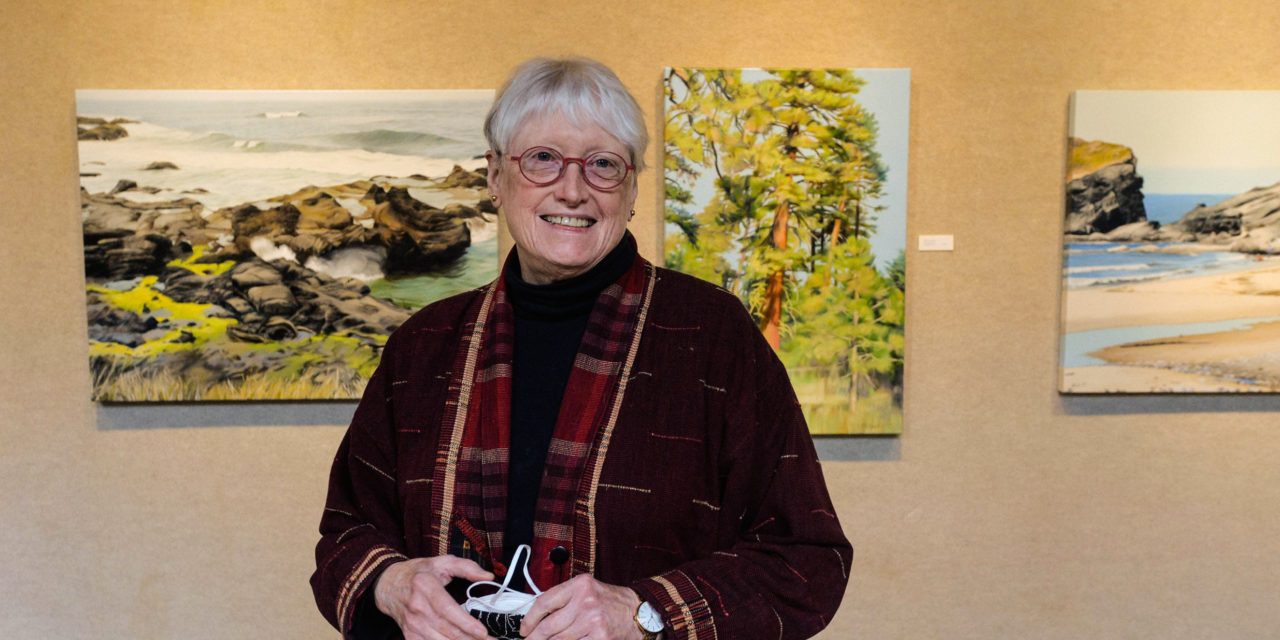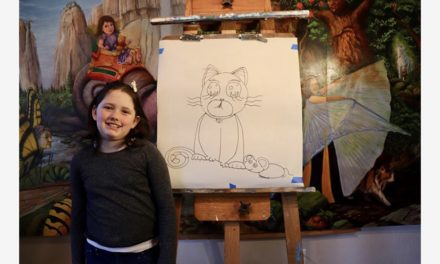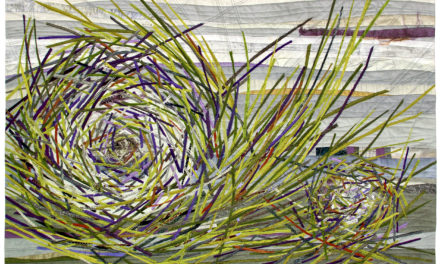(Above: Artist Margaret Prentice with pieces from her show, Coastal Waters, Desert Sands, at the White Lotus Gallery; photo by Paul Carter)
By Randi Bjornstad
“I always like to have a theme,” artist Margaret Prentice says about her approach to painting. But her new show at the White Lotus Gallery in downtown Eugene actually has two. It’s called Coastal Waters, Desert Sands, and it offers, by way of 24 pieces, an intensive exploration of two of her favorite environments.
“I did the desert series first,” Prentice says. “Color in the landscape is so important to me, and about a year and a half ago, I was interested in doing another series, following her first two, Storm Clouds in Landscape and then Wetlands: New Paintings.
A central Oregon visit to friends in Bend and Smith Rock gave her inspiration for the “desert sands” half of the new exhibit.
“I loved looking at that landscape with the rocks and sage — it was completely different from what I had been doing for a long time,” she said. “Later, I went to visit a friend in Santa Fe, New Mexico, and we traveled along the high and low road to Taos, and I took a lot of photos on that trip.”
In February of 2020 — just before the coronavirus pandemic shut down everything, including travel — Prentice made another trip, this time to Tucson, Arizona, and its surrounding desert and Santa Catalina Mountains, again capturing the shapes and colors of the land in photographs, “so I had a lot to work with when I came back and had all of this time to do another series,” she says.
She spent months working on a dozen paintings of what she had seen, capturing the colors and textures of the arid scenery in her typical painting style, which results in smooth surfaces “that express the love of the places I paint and try to communicate light, color, and atmosphere but without so many layers, in a way that lets people just fall into the space themselves.”
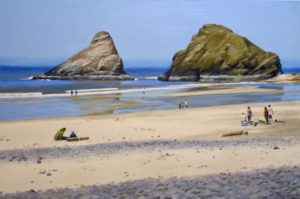
A Visit to Heceta Head Beach, painting by Margaret Prentice; the beach is one of her favorite places on the Oregon Coast
With a solo exhibit coming up at White Lotus, “I knew I needed about 24 paintings for the show, and I thought that 24 paintings of desert might be a lot, especially because I tend to paint quite large,” Prentice says. “So I thought, ‘What is the opposite?’, and of course that’s water. So I did 12 of the Oregon Coast.”
Not all the coastal paintings in Coastal Waters, Desert Sands focus on water, however. “Some of them are of rock formations that are very different from the ones in the Southwest, and those help unite both the themes of coast and desert,” she says.
The new show represents one important departure from Prentice’s past painting subjects — the inclusion of people in the landscape.
After the pandemic began, “I had an appointment on Face Time with my doctor” Prentice recalls, “and she asked me about my paintings, and I said I could show her some. I went to my studio and walked around so she could see them, and she asked me why there weren’t people in them.”
Later, Prentice gave that some thought, “and I thought, yes, why is that? Why don’t I do that? I guess I had never thought about that before. So I started in this group of paintings to incorporate some people part of the time.”
Roughly half of the coastal portion of the new show incorporates human figures, “but it’s nothing to do with portraiture or even telling a story, because the story is not about people,” Prentice says. “It’s mostly people at a distance, in groups, often with their backs to the viewer. I use them mostly to convey a sense of proportion to the scene. But I’m so glad my doctor asked me that question.”
Several of the paintings in the show are scenes of the Heceta Head Beach, “one of my favorites,” she says. “It’s such a special place, where people love to go. I’ve never painted the lighthouse as such, but I have done a view of the beach looking up toward it.”
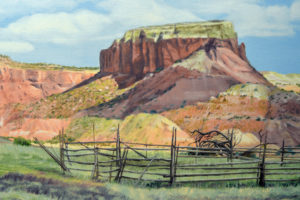
Scenes such as Nearing Mountains in Desert Heat make up the Desert Sands half of Prentice’s solo show at the White Lotus Gallery
Prentice and her identical twin sister grew up in Indiana, and in 2009, when Prentice was undergoing chemotherapy and radiation for uterine cancer, her sister came to help care for her.
“Before she left, my sister said she couldn’t go back without seeing the ocean, so we went to Heceta Head Beach,” she recalls, and that journey provided the impetus of a whole new way for her to create art.
“Until that point, I had been a printmaker for my entire career, but because of my illness and treatment, I couldn’t even stand up for more than about 15 minutes — I had lost all my energy,” she says. ” My sister suggested that I try doing some still life painting, and she bought me a little tabletop easel so I could sit down and entertain myself. I had done drawing and composition and color with my printmaking, so I was familiar with that, so the learning curve for me was using actual paint and brushes.”
She learned by setting her computer next to the easel and painting from photographs that she had taken at the coast on the trip with her twin. “I did that for a year or so, and I enjoyed it,” Prentice says. But then she realized that just as she had focused on creating large prints during her 26-year career on the arts faculty at the University of Oregon, she also wanted to paint bigger canvases.
“My prints had always been large and colorful, with 6-10 colors — even up to 15 — and usually 22×30 or 30×40 inches,” she says. “And one day I heard on the radio an interview with a retired graphic artist who said he’d spent his entire career problem-solving for clients, but now he wanted to paint what he wanted, which was the landscapes where he walked every day.”
Listening to that interview, Prentice realized she also wanted to paint what she wanted, and she wanted to do it on a theme, capturing landscapes in myriad photographs and then rendering them large in her home studio. “That’s what got me started on the whole experience of my painting, and I still approach it in that way.”
When she was a printmaker, “It was all imagination, what you might even call magical realism,” she says. “But when I went out in landscapes, I became fascinated by the detail in everything I saw, and I would ask myself how I could do that in paint. It’s a very different subject matter — atmosphere, space, texture, and color — and I feel it’s something that is really important to communicate.”
Her paintings fall somewhere between realism and impressionism in that she values enough detail “to pull you into the landscape” as well as “experiencing the atmosphere created by the shapes and colors and textures of the brushstrokes.”
As for what’s next in the way of a theme, Prentice isn’t exactly sure, “but I have never painted cities or interiors,” she says. “I probably will try something like that, just to see what it’s like.”
Coastal Waters, Desert Sands
When: Through April 24
Where: White Lotus Gallery, 767 Willamette St., Eugene
Hours: 10 a.m. to 4 p.m. Tuesday through Saturday
Information: Telephone 541-345-3276; email lin@wlotus.com; or online at wlotus.com

